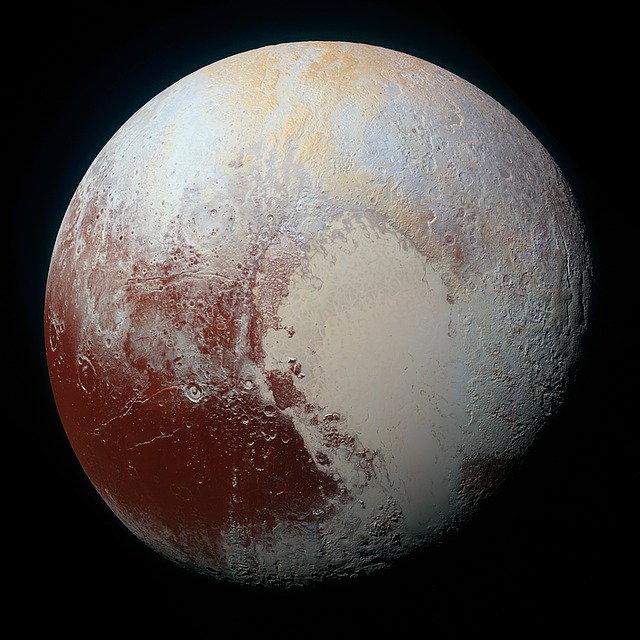
Mon 26 Aug 2019 06:51
Why we thought for a while Pluto was a planet, but it never was.

More than a decade after Pluto's demotion from the rank of planet, some still do not accept it. I can sympathize. Like many of us, I grew up memorizing in school the nine planets of the Solar system, the last of which was Pluto: icy, distant and mysterious. I remember as a child poring over a diagram of the solar system, marvelling at the concentric elipses of the planetary orbits, and wondering why Pluto's orbit was so odd. For odd it was: all the other planets orbited the sun in more or less concentric elipses, but Pluto was eccentric: its orbit was at an unusual angle, and it even briefly came closer to the sun than Neptune. None of the other plants had orbits like this: why Pluto? But I didn't question that it was a planet. It had been recognized as a planet since Clyde Tombaugh discovered it before my parents were born. For me, Pluto was weird, but it was still "planet", the astronomical equivalent of a sort of odd uncle who behaved strangely and kept to himself, but still family.
But the idea of Pluto as a planet started to become problematic in the early 1990s. In 1992, Jewitt and Luu discovered another object beyond Neptune: Albion, much smaller than Pluto, and also with an odd orbit. Because it was a small object, it was pretty clearly not a planet, so Pluto's status was not yet in question, but it was only the first of many. By 2000, more than seventy such objects had been discovered. Most of these were very small, but some were not so small. And the discoveries continued. In 2003, with the discovery of the Eris, a trans-Neptunian body more massive than Pluto itself, the problem became acute. No longer was Pluto the odd uncle of the planets: now there were on the order of 100 odd uncles and aunts, and at least one of them, Eris, aptly named after the greek goddess of discord, had a better claim to planethood than Pluto itself. Something had to be done. This bunch of odd objects, odd in the same way as Pluto, were either all planets, or they were none of them planets. There was no reasonable distinction that could be made that would keep Pluto a planet but deny planethood to Eris and many of her siblings. To do so would be arbitrary: we would be saying that Pluto was a planet simply because we discovered it first and it took us a long time to discover the others. What to do?
Happily, there was a precedent: this sort of thing had come up before. In 1801, Giuseppe Piazza discovered Ceres, a body orbiting between Mars and Jupiter. This was a big deal. Only twenty years before, a new planet had been discovered for the first time in recorded history: Uranus, found by accident by William Herschel in 1781. Now, twenty years later, Piazza had found a second. And this one was not out beyond Saturn, it was nearer than Jupiter. But Piazza's share of the limelight was soon to lessen. his planet had a rival: a year later, Heinrich Wilhelm Olbers discovered Pallas, another body between Jupiter and Mars. Two years later, in 1804, Karl Harding discovered another: Juno. Not to be outdone, Olbers in 1807 discovered yet another, Vesta. By the middle of the 19th century, fifteen bodies orbiting between Mars and Jupiter were known, and while none of them were anywhere as large as Ceres, one of them, Vesta, had nearly a third of Ceres' mass. Were there really many small planets between Mars and Jupiter, or were these something else? When in 1846 the planet Neptune was discovered beyond Uranus, it became clear that some decision about these bodies between Mars and Jupiter needed to be made. A consensus emerged: Ceres and other such objects were not planets. They were called "asteroids", a name coined in 1802 by William Herschel. It was a good call: there are now well over 100,000 known asteroids, far too many for schoolchildren to memorize.
With Pluto, a similar situation was now occurring. While we weren't yet at 100,000 Pluto-like bodies, we knew about quite a few more than fifteen. And Pluto, unlike Ceres, wasn't even the most massive: Eris was, and quite possibly, bigger ones would be found. There was no denying the facts. Pluto, like Ceres, could not be a planet. It must be something else.
Of course this was quite controversial. People had been calling Pluto a planet for the better part of a century. Generations of schoolchildren had memorized it as part of the list of planets. But the choice was clear: either the schoolchildren would have to start memorizing longer lists, much much longer ones, or Pluto would have to be demoted. Well, not demoted, exactly, but newly recognized for what it really was all along: something different. In the sumer of 2006, the International Astronomical Union (IAU) declared that Pluto isn't a planet, it is a dwarf planet. While this designation is a little confusing (if a dwarf planet isn't a planet, why is it called a dwarf planet?), one thing was now clear: Pluto is not the same sort of thing as Mercury, Venus, Earth, Mars, Jupiter, Saturn, Uranus and Neptune; it, and Eris, and probably a couple of other larger trans-Neptunian bodies discovered since the 1990s, are something different. But guess what: Ceres, too, fits IAU's definition of dwarf planet, the only asteroid that does. Two centuries after its discovery, Ceres, first-born of the non-planets and largest of the asteroids, was deemed a dwarf planet, and Piazza, its discoverer, though not the second person in recorded history to discover a new planet, was recognized as the very first to discover a dwarf one.
